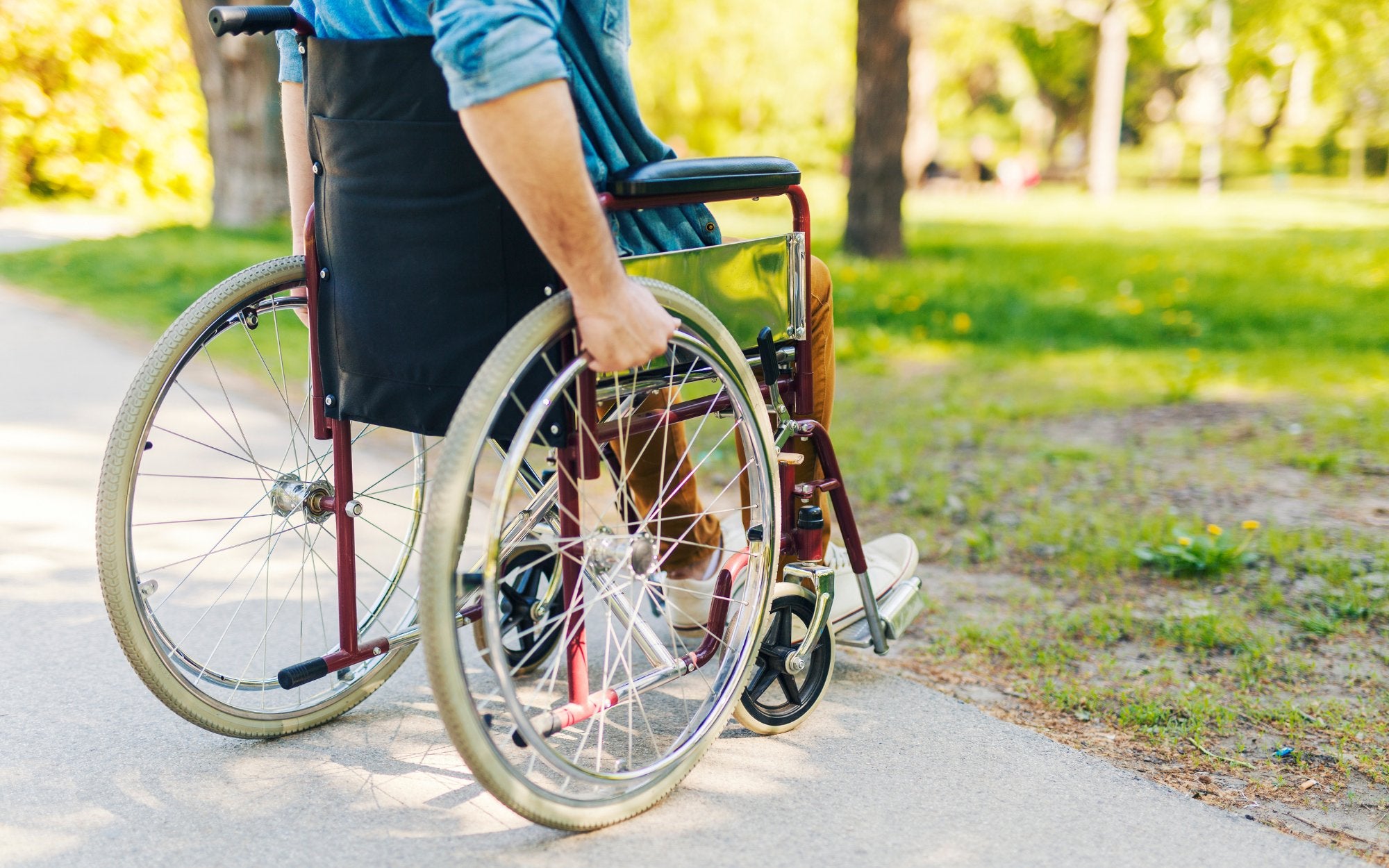Spinal Cord Injuries & UTIs: Your Guide to Preventing UTIs

Living with a spinal cord injury comes with a world of unique challenges. Whether you’re in a wheelchair or facing a new reality of limited mobility, you have to consider countless health concerns you might not have before.
In the US alone, about 10,000 people suffer a severe spinal cord injury (SCI) every year, often leading to permanent complications. Of them, more than 80% experience some degree of bladder dysfunction. That’s why urinary tract infections (UTI) are such a common issue for people living with SCI.
Your urinary tract consists of your kidneys, bladder, ureters, and urethra. A UTI is caused when new or existing bacteria grabs hold of your urinary tract lining and spreads. Most people, especially women, will experience at least one UTI in their lifetime. But for those suffering from a spinal cord injury, frequent or chronic UTIs are all-too-common.
Take DeUndre for example: a gunshot victim who faced countless UTIs over 20+ years in a wheelchair.
Meet DeUndre: gunshot victim and frequent UTI survivor
After a night out in college went horribly wrong, DeUndre was faced with a new reality: life with a spinal cord injury.
“I was a victim of gun violence and that changed my life tremendously, but as long as I have my faith in God and family I will be okay. I’m blessed to still be here and to bring hope and love to others.”
How does spinal cord injury affect the bladder?
After over two decades in a wheelchair, DeUndre has dealt with constant bladder problems and frequent UTIs.
Your spinal cord is responsible for sending and receiving signals from your entire body. These signals help you move your arms, legs, and muscles and allow your bladder and bowels to empty out. If your spinal cord is damaged, your bladder may not receive the signals it needs to do its job.
There are different types of spinal cord injuries. When the injury is higher on the spinal cord, the bladder and sphincter muscles can start working against each other. This builds up pressure in the bladder, which can force urine back into the kidneys.
When the injury is lower on the spinal cord, you start losing muscle tone in your bladder and sphincter. This makes it harder for your pee muscles to contract and loosen.
All of these bladder problems can create the prime environment for bacteria to spread and cause infection.
Why do paraplegics get UTIs?
Bladder dysfunction caused by SCI can lead to incomplete emptying, incontinence (also known as bladder leaking), and sphincter muscles that don’t work properly. These conditions allow bacteria to stick around longer than they normally would. Enter: a UTI.
Lack of accessible public washrooms is also a cause of UTI for people with spinal cord injuries. If you’re forced to hold in your pee for large amounts of time, bacteria sitting in the urinary tract doesn’t get flushed out. This is a major issue for SCI patients that can lead to chronic UTIs or severely limited water intake.
Symptoms of UTI for SCI patients typically include fever, foul-smelling urine, blood in the urine, or urine with a dark colour. DeUndre has experienced these symptoms (and more) multiple times.
“Some of my symptoms that I have experienced when I get a UTI are fever, lethargicness (I sleep a lot) and spasms, something that I normally don't get. My urine also gets very dark.”
Catheterization is another common cause of UTIs for people living with a spinal cord injury. A catheter is inserted into the urethra and bladder to help drain your urine.
Many SCI patients do intermittent self-catheterization, inserting the catheter when they need to and removing it when their bladder is emptied. Other SCI conditions require indwelling catheterization, which is when the catheter and urine bag stay in place consistently.
Why does catheterization increase the chances of UTI?
When a catheter is inserted, it comes into contact with bacteria on the tip of the urethra and brings it into the urinary tract. It can also shift bacteria already in the urinary tract. Both situations can motivate bad bacteria to cause an infection. On top of that, about 3 in 10 people who use an indwelling urethral catheter get bladder stones, which often lead to UTIs.
For DeUndre, he believes that catheterization and sex have both been contributors to his frequent UTIs - many of which have landed him in the hospital.
“Being in a wheelchair and getting UTIs has put me in the hospital for days, on IV and medicine and being sent home with additional medicine. I’m still learning about UTIs. I can say [I get them] after having sex or catheter a lot.”
What are the challenges associated with UTIs in paraplegics?
Constant bladder problems and catheterization make recurrent UTIs a big challenge for SCI patients. And with so many potential causes, it can be difficult to pinpoint exactly why UTIs are happening. For people like DeUndre, this can quickly lead to antibiotics overkill.
“After having several tests and scans of my kidneys and bladder, they could never determine what was causing the UTIs and were constantly prescribing antibiotics that would only work temporarily.”
Another challenge is simply identifying UTIs in the first place. Since many spinal cord injuries result in a loss of sensitivity, typical UTI symptoms - like the constant urge to pee or burning sensations - aren’t experienced.
If a UTI is left undetected for too long, it can spread to the kidneys and potentially cause kidney damage or sepsis - a life-threatening blood infection.
How do paraplegics prevent UTIs?
Recent studies show that 30% of SCI patients who lose control of their bladder may get it back at some point after their injury. But until then, it’s important to take action and avoid risk. Here are our top UTI prevention tips for people living with an SCI.
- Stay hydrated
Drink at least 6 to 8 glasses of water per day. Although bladder dysfunction can be frustrating, it’s important to pee as often as you can to keep bacteria flushed out of your urinary tract. Drinking plenty of water will also dilute your urine, which helps deconcentrate a UTI already in progress.
Pro tip: avoid sugary or caffeinated beverages. Caffeine irritates the bladder and bacteria feeds on sugar to grow and spread.
- Practice proper catheterization hygiene
Always throw away your catheter after using it. Even if a catheter is professionally cleaned, it will still have bacteria, viruses, and other microorganisms left behind on it. By re-using a catheter, you’re introducing those bacteria back into your urinary tract where it can cause an infection.
Before and after inserting a fresh catheter, always clean off your urethra area with high-quality cleansing wipes. Wash your hands and use gloves when possible to avoid extra bacteria entering your tract. And most of all, review your catheter technique regularly with a healthcare professional to make sure you’re always reducing your risk of UTI.
- Try a more advanced catheter
Consider using a hydrophilic or pre-lubricated closed system catheter. These catheter types can help minimize hand contamination and make for a more comfortable and sterile situation.
Most closed system catheters also have an introducer tip, which is designed to help reduce the risk of UTIs. The introducer tip shields the catheter tube from coming into contact with bacteria that is sitting at the tip of the urethra.
- Take d-mannose supplements
D-mannose is a natural sugar that attaches to E. coli bacteria and prevents it from sticking to your urinary tract lining. If the bacteria can’t stick, it’ll be flushed out through your urethra (or a catheter) when you pee.
Since the majority of UTIs are caused by E. coli, taking an all-natural d-mannose supplement with at least 500mg per dose can significantly reduce the UTI cycle. Utiva’s D-Mannose supplement is doctor recommended, 100% plant-based, and antibiotic-free.
- Take daily PACs supplements (with at least 36mg per dose)
PACs, also known as proanthocyanidins, are all-natural compounds derived from cranberries. They are clinically proven to stop bacteria from sticking to your urinary tract, making them a powerful UTI prevention tool.
Utiva’s Cranberry PACs supplement contains 36mg of PACs in each dose and is recommended by doctors to stop UTIs before they begin. In fact, it was this exact supplement that helped DeUndre finally get control of his frequent UTIs.
“I found out about Utiva from a friend after I experienced a UTI that was so bad that I was hospitalized for a week. So at my friend’s recommendation, I contacted Utiva to try their product. Since being on Utiva’s Cranberry PACs supplement, I have not experienced any more UTIs and I couldn’t be happier.”
Keep learning about spinal cord injuries & UTIs
The most important thing to remember about spinal cord injuries is that you’re not alone. There are so many other people living with an SCI who are discovering new and proactive ways to improve their bladder health, prevent UTIs, and live a happy and fulfilled life.
For DeUndre, being in a wheelchair has changed his entire outlook on life.
“After being in a wheelchair, it has changed my life tremendously. How you look at things we take for granted. Now you look at life and appreciate everything. God has given me the strength to even deal with UTIs.”
By staying positive and educated on the tools and techniques that keep him healthy, DeUndre has found a solution to his UTIs.
Want to join the UTI conversation and stay in the know about bladder health? Go to www.utivahealth.com for resources, prevention tips, and powerful, Canadian-made products.
Knowledge is power
Sign up to our newsletter to keep learning!

- Choosing a selection results in a full page refresh.
- Opens in a new window.




